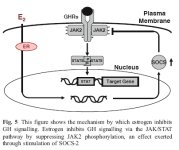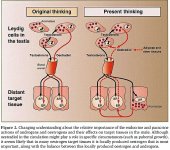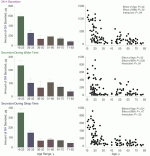Okay Welt... I'm sorry I haven't gotten back to you on your question on the pharmacokinetics of long-acting insulin. I don't have an answer for you.
But I do question the wisdom of having chronically elevated insulin levels.
The more I research...the more I discover rhythms and rhythms that relate to other types of rhythms. What we are talking about could simply be thought of as communication between & among cell groupings and activation, deactivation and modulation of intracellular mechanisms.
Anecdotally we can look to
BigKiwi who posted that he used insulin to great effect in place of GH because he could not get GH in his part of the world. He grew...
Scientifically, we can attempt to explain
BigKiwi's results by understanding that insulin as does GH, directly activates STAT5 via its own receptor in vivo. -
Insulin selectively activates STAT5b, but not STAT5a, via a JAK2-independent signalling pathway in Kym-1 rhabdomyosarcoma cells, Peter Storz, FEBS Letters 464 (1999) 159-163
But that doesn't tell a bodybuilder how best to optimize insulin use.
There is a lot of evidence that periods of repression lead to periods of excess and vice versa. This is true on so many levels of human life. If you are flush with money and spend a lot if you become poor you cut spending back to the bare essentials. If you are poor and suddenly have a lot of money you buy more things and probably accumulate a lot of things you don't need. Your lifestyle grows.
This general rule seems to apply to our basic biology as well. For example,
Catch-Up Growth after Glucocorticoid Excess: A Mechanism Intrinsic to the Growth Plate, Jeffrey Baron, Endocrinology 136: 1367-1371,1994
In humans and other mammals, the release from growth-inhibiting conditions, such as glucocorticoid excess, leads to supranormal linear growth....Here we show that suppression of growth within a single growth plate by locally administered glucocorticoid is followed by local catch-up growth that is restricted to the affected growth plate....To explain this finding, we propose that the normal senescent decline in growth plate function depends not on age per se, but on the cumulative number of stem cell divisions, and that glucocorticoid administration, by suppressing stem cell proliferation, delays senescence, resulting in catch-up growth after the growth-inhibiting agent is removed.
As a further but distinct example, we often find that greater amounts of potential muscle growth come from a growth factor (such as a fibroblast growth factor (FGF-2)) acting to repress skeletal muscle differentiation. It is the repression of differentiation that allows proliferation to continue unimpeded. When that repression is removed all of the proliferated myoblasts undergo differentiation.
It is the repression of differentiation by the growth factor FGF-2 that allows many more potential muscle cells to be created. When that inhibiting factor is removed and the growth factor FGF-4 is allowed to act via differentiation of those newly created cells noticeable skeletal muscle cells develop.
So repression leads to excess or substantial growth.
What happens if myoblast proliferation is drastically reduced because we are constantly allowing factors which differentiate to act? We lose potential muscle that we will never regain... and we have no or reduced growth.
Rhythms are important.
Rat studies don't correlate with humans but it is interesting to observe the interplay between GH pulses and insulin pulses in the troughs.
From,
Pulsatile secretion of growth hormone and insulin in relation to feeding in rats, Patrick Even, Am J Physiol Regulatory Integrative Comp Physiol 253:772-778, 1987
The existence of 3-h pulsatile cycles of GH secretion was confirmed. In addition, short bursts of insulin secretion were observed in the middle of every second GH peak-to-peak interval.
In humans we find that, "insulin-regulated resensitization of GH signaling may be necessary to reset the complete response to GH after a normal, physiologic pulse of GH."
We further find that, "Insulin restored the ability of a second GH exposure to induce phosphorylation of MEK1/2 and ERK1/2 without altering GH receptor levels or GH-induced phosphorylation/activation of JAK2 and Raf-1.
GH and insulin synergized in promoting cell proliferation." -
Insulin Reverses Growth Hormone-induced Homologous Desensitization, Jie Xu, Zhongyu Liu, Thomas L. Clemens, and Joseph L. Messina, THE JOURNAL OF BIOLOGICAL CHEMISTRY VOL. 281, NO. 31, pp. 21594–21606, August 4, 2006
See also:
Insulin Enhances Growth Hormone Induction of the MEK/ERK Signaling Pathway by the same authors in the same journal published earlier that year.
I don't want to ramble on...but I do want to emphasize that yes insulin (even physiological levels) are important to promote growth with growth hormone, but that chronic always on levels of insulin are not what is desirable.












































































